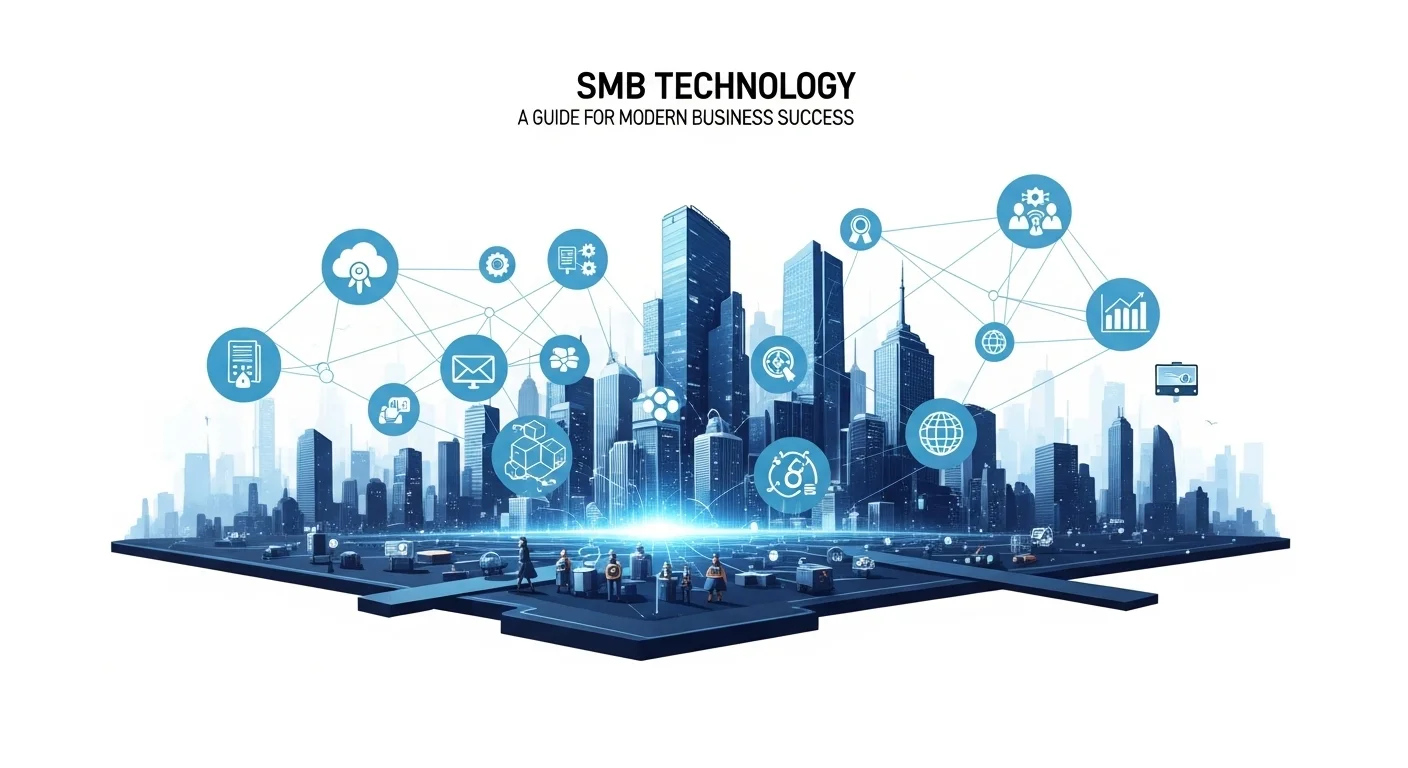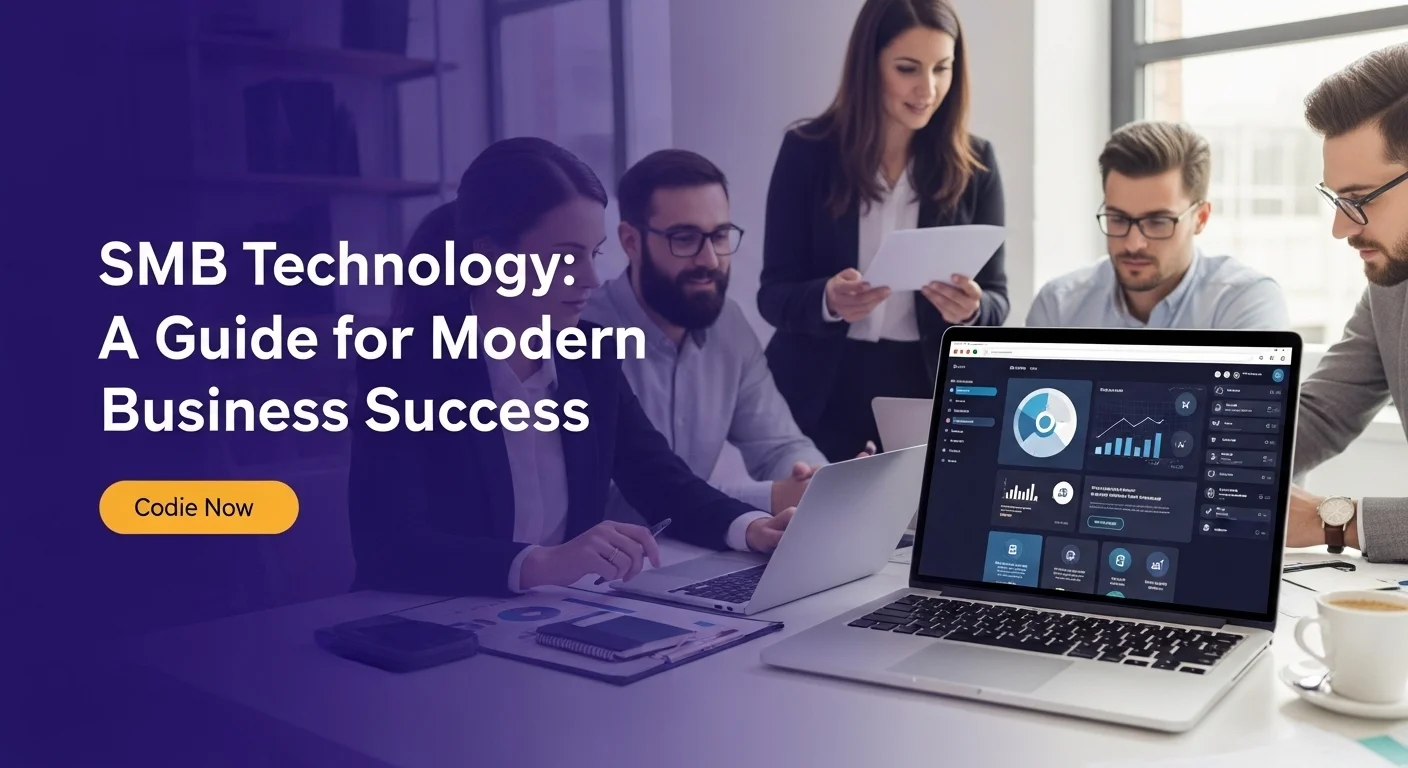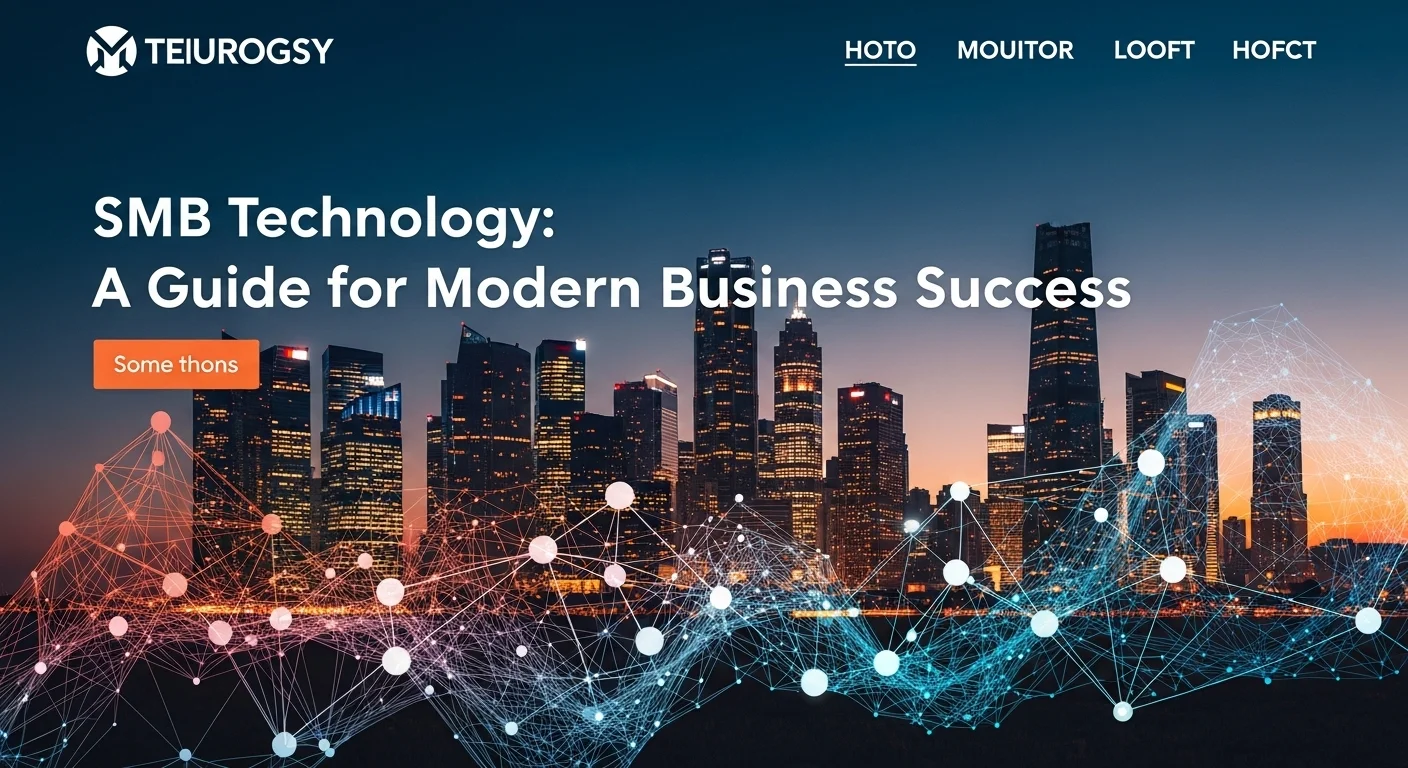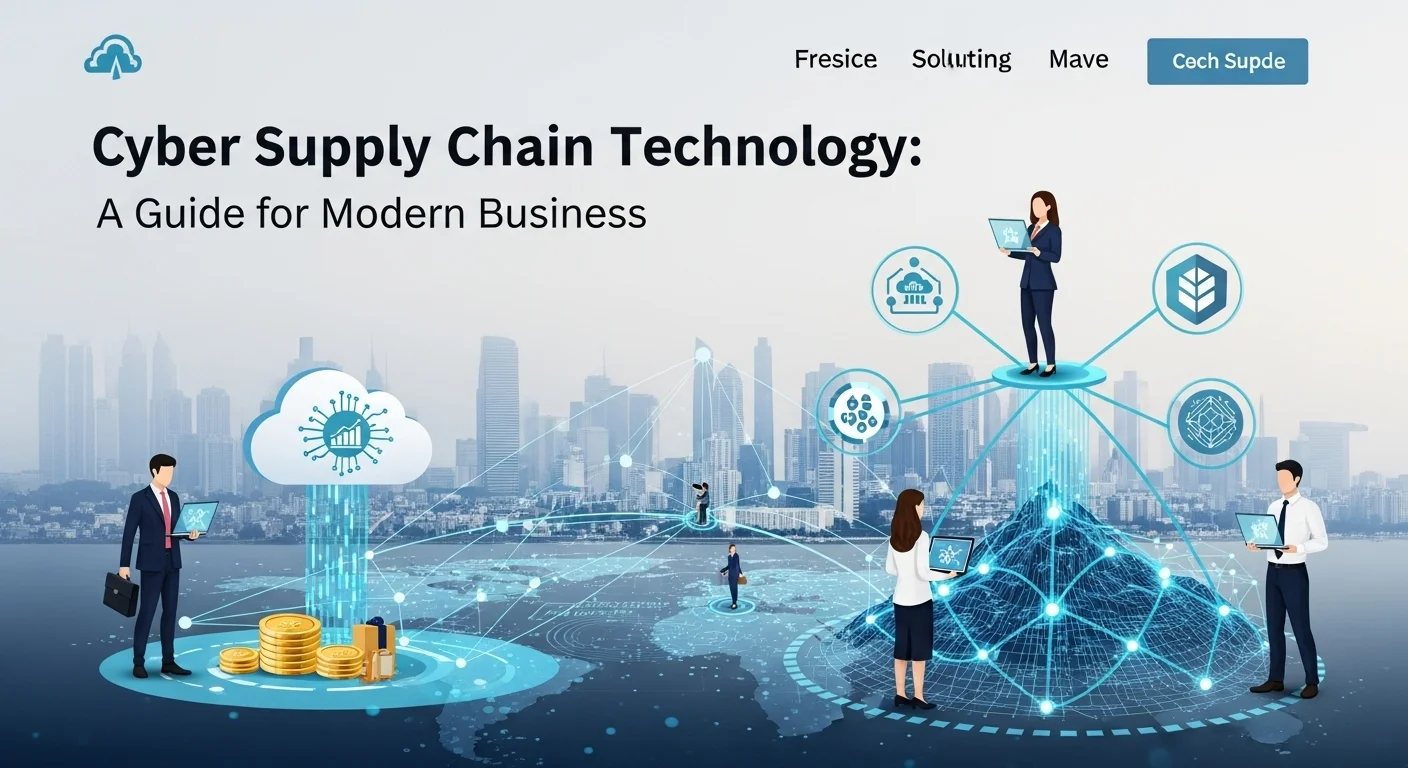Smart Tech for Small Business: Your Guide to Growth and Security

Executive Summary
In my years of helping small and medium-sized businesses (SMBs), I've seen one thing change the game more than anything else: the smart use of technology. If you're running a small business today, you know it's a tough world out there. It often feels like you're competing with giants. But technology is the great equalizer—it's your secret weapon. This isn't about complicated, expensive systems; it's about finding the right tools to make your life easier and your business stronger. In this guide, I'll walk you through a clear path for your digital journey. We’ll cover the essentials, like how to protect your hard work with solid SMB cybersecurity and how to secure your digital workspace with smart network security. We'll also explore the exciting world of AI for SMBs and show you how it can automate tedious tasks and give you amazing insights. And for those who feel overwhelmed, we'll talk about when it makes sense to bring in the pros with managed security services. Let's get you set up to not just compete, but to win.
Table of Contents
Table of Contents
- Why Smart Tech is a Game-Changer for Small Businesses
- Keeping Up and Getting Ahead: Your Digital Leap
- The 3 Tech Pillars Every Modern SMB Needs
- An Introduction to SMB Cybersecurity: Protecting Your Business
Why Smart Tech is a Game-Changer for Small Businesses
When we talk about Small and Medium-sized Businesses (SMBs), we're talking about the heart of our economy. These are the neighborhood cafes, the family-run factories, the creative startups, and the expert consultants that build our communities. In the U.S., a business with fewer than 500 employees is generally considered an SMB. You're the engine of innovation and job creation. But being smaller can also mean having fewer resources than the big guys. I've seen firsthand how this can be a struggle. This is exactly where technology comes in. It’s not just about having a website or using email; it’s a powerful force that can level the playing field, helping you work smarter, reach more customers, and protect everything you've built.
Keeping Up and Getting Ahead: Your Digital Leap
‘Digital transformation’ sounds like a big, scary buzzword, but it's actually something very simple and vital for SMBs. It’s about shifting from old ways of doing things to smarter, digital methods that improve your business. Think about moving from a paper ledger to a simple cloud accounting program like QuickBooks, or adding an online store to your physical shop. Why is this so important? First, your customers expect it. They want easy, fast, and personalized service, no matter who they're buying from. Second, your competitors are doing it. Technology helps you automate the boring, repetitive tasks, which frees you and your team up to focus on what really matters: your customers and your growth. Finally, technology helps you use your own data to make smarter decisions. You can learn what your customers really want, spot new trends, and find ways to be more efficient—power that used to belong only to massive corporations.
The 3 Tech Pillars Every Modern SMB Needs
To start your digital journey on the right foot, you need a solid foundation. I always advise my clients to focus on three core areas that work together to support the entire business.
- Cloud Computing: This is probably the biggest enabler for any SMB. Instead of buying expensive servers and hardware, the cloud lets you 'rent' powerful tools and infrastructure on a simple pay-as-you-go plan. For most of us, this means using Software as a Service (SaaS) apps. You’re likely already using them! Think Microsoft 365 or Google Workspace for email, Xero for accounting, or Trello for managing projects. It’s enterprise-level power on a small business budget.
- Data Analytics: Your business creates a ton of data every day from sales, your website, and social media. Tools like Google Analytics or Microsoft Power BI can turn those raw numbers into clear insights. I once helped a small retailer use their data to discover their most loyal customers and create a special rewards program, which boosted their sales by 20%. That’s the power of listening to your data.
- Customer Relationship Management (CRM): A CRM is more than just a contact list; it's the command center for all your customer interactions. A good CRM like HubSpot or Zoho helps you track sales leads, manage customer communication, and create marketing that people actually find useful. It ensures every customer feels seen and valued, which is how you build loyalty.
An Introduction to SMB Cybersecurity: Protecting Your Business
As you embrace technology, you also open your door to new risks. I’ve heard too many business owners say, 'We're too small to be a target for hackers.' That is a dangerous myth. In reality, criminals often target SMBs because they know security might be weaker. A cyberattack can be devastating, leading to lost money, a damaged reputation, or worse. That's why SMB cybersecurity isn't just an 'IT thing'—it's a core business function. The threats are varied, from phishing emails that try to steal your passwords to ransomware that locks up your files. Good SMB network security is your first line of defense. This includes the basics like a strong firewall, secure Wi-Fi, and a VPN for anyone working remotely. For many businesses, the complexity of modern threats makes it smart to look for expert help. This is where managed security services for SMBs come in, giving you access to a team of pros at a fraction of the cost of hiring your own. And today, advanced tools like AI for SMB security can even spot and stop threats automatically. Protecting your business is a constant process, but it starts with taking that first step.

A Practical Guide to Business Tech and Security Solutions
Once you've got the basics in place, it's time to get strategic. This is about moving from simply using technology to using it as a competitive advantage. It means getting serious about your cybersecurity, exploring how artificial intelligence can really help, and making smart choices about who you partner with. I've worked with countless SMBs to navigate this stage, and the goal is always the same: to build a business that's not just efficient, but also resilient and ready for the future. Let's dive into the practical solutions that can make a real difference.
A Deeper Look at SMB Cyber and Network Security
A simple antivirus program isn't enough anymore. A truly strong SMB cybersecurity plan is like a fortress with multiple layers of defense. It's about understanding the real threats and having the right tools to stop them.
- Understanding Today's Threats: The game has changed. Beyond simple viruses, you need to be aware of clever social engineering tricks, ransomware that not only locks your data but threatens to leak it, and 'zero-day' attacks that exploit brand-new vulnerabilities. It's not to scare you, but to prepare you.
- Using a Security Framework: Instead of guessing what to protect, use a proven plan. The NIST Cybersecurity Framework is a great model that can be simplified for SMBs. It's based on five simple steps: Identify (know what you need to protect), Protect (put safeguards in place), Detect (spot threats as they happen), Respond (have a plan to act), and Recover (get back to business quickly). This gives you a clear, structured way to manage risk.
- Endpoint Detection and Response (EDR): Think of this as a security guard for every device (laptops, phones) in your company. Unlike old antivirus software that just reacts to known threats, EDR proactively watches for suspicious activity, alerts you in real-time, and helps you stop an attack in its tracks. For an SMB in cybersecurity, this is a huge leap in protection.
- Strengthening Your Network Security: Your network is the highway for all your data. Key strategies for solid SMB network security include:
- Next-Generation Firewalls (NGFW): These are smarter firewalls that don't just check the address on the mail, but actually open it up to see what's inside, giving you much deeper protection.
- Network Segmentation: A simple but powerful idea. You divide your network into separate zones. For example, your guest Wi-Fi should never be on the same network as your financial data. If a hacker gets into one area, they're trapped there and can't access your most critical systems.
- Zero Trust Thinking: The old idea was to build a strong wall around your business. The new idea, Zero Trust, is to assume threats could already be inside. It means every user and device has to prove who they are every single time they try to access anything. It’s the new gold standard for security.
Putting AI to Work for Your Small Business
Artificial intelligence isn't just for tech giants. For an SMB, AI is a practical tool that can solve real-world problems and give you back your most valuable resource: time.
- Smarter Marketing and Sales: AI tools can analyze your customer data to figure out which leads are most likely to buy. They can personalize your website for each visitor or help your sales team by automatically logging notes and suggesting what to say next.
- Streamlined Operations: I worked with a small manufacturing firm that used a simple AI tool to predict their inventory needs. It drastically cut down on waste and ensured they never ran out of key parts during a busy season. AI can also help service businesses with smart scheduling and resource planning.
- 24/7 Customer Service: Modern AI chatbots can handle common customer questions anytime, day or night. This frees up your human team to solve the more complex problems that require a personal touch.
- How to Get Started with AI: You don't need to be a data scientist. Many of the business tools you already use (like your CRM or marketing software) have powerful AI features built right in. My advice is to start small. Pick one problem, like answering repetitive customer emails, and run a small pilot project to see the results.
Is a Managed Security Service Right for You?
Hiring a full-time cybersecurity expert is expensive and difficult. This is why many smart SMBs partner with a managed security services SMB provider (MSSP). Think of them as your on-demand, expert security team.
- What They Do: An MSSP monitors your systems 24/7. They manage your firewalls, look for vulnerabilities, and respond to threats the moment they're detected. Often, they'll neutralize a threat before you even knew it existed.
- The Financial Sense: While there's a monthly fee, it's almost always cheaper than hiring an in-house team. More importantly, the cost of a single data breach can easily be 10 or 20 times the annual cost of an MSSP. It's an investment in peace of mind and business continuity.
- Choosing the Right Partner: Look for a provider who feels like a true partner, not just a vendor. They should offer clear reports, explain things in plain English, and be invested in your success. A good MSSP is a critical part of a modern SMB cybersecurity strategy.

Long-Term Strategies to Master Your Business Technology
Once you've set up your core technology and security, the journey isn't over. The best businesses I've seen are the ones that treat technology as a living part of their strategy. It's about continuously improving, staying aware of what's next, and building a company culture that embraces smart tools. Here are some of my go-to tips and strategies to help you get the most out of your tech investments for years to come.
Build a Technology Roadmap and Budget
The smartest tech decisions are planned, not panicked. Instead of reacting to problems, create a simple technology roadmap that aligns with your business goals for the next 1-3 years.
- Know What You Have: Start with a quick audit of your current tech. What are you paying for? What's working well? Are you paying for two different apps that do the same thing? Find the gaps and the waste.
- Connect Tech to Goals: If your goal is to grow online sales, your roadmap should include things like improving your e-commerce site or adopting a new marketing tool. Every tech investment should clearly support a business objective.
- Budget for Success: Technology needs its own line in your budget, not just leftover funds. This should cover subscriptions, maintenance, training, and a little extra for unexpected needs, like replacing a critical laptop.
Practical Tips for Everyday SMB Cybersecurity
Your people are your most important asset, but they can also be your biggest security risk. Building a security-aware culture is the most effective part of any SMB cybersecurity plan.
- Build Your Human Firewall: Security training should be an ongoing conversation, not a boring annual meeting. Use tools that send simulated phishing emails to your team to see who clicks—it’s a powerful learning experience. Teach everyone about using strong, unique passwords with a password manager and the importance of multi-factor authentication (MFA).
- Have a Plan for When Things Go Wrong: Don't wait for a crisis to decide what to do. Create a simple Incident Response (IR) plan. It's a checklist for what to do in case of a breach, who to call (including your managed security services SMB provider), and how to communicate with customers. Practice it once a year.
- Test Your Defenses: You wouldn't wait for a burglar to test your locks. Regularly scan your network for vulnerabilities. For businesses with sensitive data, it's worth hiring ethical hackers for a 'penetration test' to find weaknesses before the bad guys do. This is a key part of maintaining strong SMB network security.
Practical Steps for Bringing AI into Your Business
Getting started with AI doesn't have to be overwhelming. The secret is to use AI for your SMB to solve specific problems and deliver real value.
- Start Small, Aim High: Don't try to overhaul everything at once. Find one big pain point. Is your team drowning in repetitive data entry? Are you struggling to figure out which customers to focus on? Start with one pilot project using a simple AI tool.
- Check Your Current Toolbox: Before buying new software, look at what you already have. Your CRM, accounting software, or email marketing platform might have powerful AI features just waiting to be turned on. This is a low-risk way to get started.
- Good Data In, Good Results Out: An AI is only as smart as the data you give it. Before you start, take some time to make sure your customer data is clean and organized. It's the most important rule of AI.
Getting the Most from Your Tech Partners
Your software vendors and your MSSP are vital members of your team. Managing these relationships well is key to your success.
- Demand a Partnership, Not a Transaction: Treat your key vendors, especially your managed security services SMB provider, like strategic advisors. Set up regular calls to review progress and discuss your goals. A partner who understands your business can give you much better advice.
- Review and Hold Accountable: Make sure you have clear Service Level Agreements (SLAs) that define expectations. Review their performance. A strong partnership is built on transparency and accountability, which is essential for your SMB's cybersecurity.
What's Next: Future Tech for SMBs
You don't need to chase every shiny new object, but it's smart to keep an eye on the horizon.
- The Internet of Things (IoT): Smart devices, from sensors to equipment, can provide incredible data. But remember, every new device is a new door into your network, so security is a top priority for your SMB network security plan.
- The Future is Zero Trust: This security model is quickly becoming the standard. Start thinking about how you can move towards a 'never trust, always verify' approach to security.
For more great advice on building a resilient business, the U.S. Small Business Administration has fantastic resources on planning for all types of emergencies, including cyber threats. By following these strategies, you can turn technology into your most powerful tool for growth, innovation, and security.
Expert Reviews & Testimonials
Sarah Johnson, Business Owner ⭐⭐⭐⭐
This was a great starting point. I especially found the breakdown of cybersecurity risks helpful. I would have loved to see a case study of a retail business like mine implementing some of these tools.
Mike Chen, IT Consultant ⭐⭐⭐⭐⭐
As an IT consultant, I'm always looking for resources to share with my SMB clients. This article nails the core concepts without getting overly technical. The section on choosing an MSSP is particularly well-explained.
Emma Davis, Tech Expert ⭐⭐⭐⭐⭐
Fantastic and comprehensive guide! As someone deep in the tech world, I appreciated the clear, strategic advice. It connects the dots between the technology itself and real-world business growth. A must-read.



